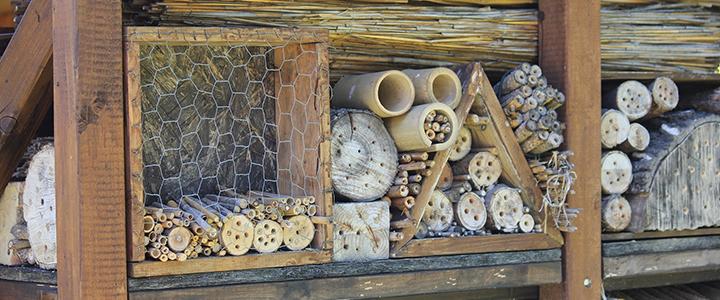
June 2020: Offering Our ‘Solitary Bees’ Room and Board
When scientists talk about the importance of bees as pollinators and the benefits to our planet, did you know they are talking about native, or solitary, bees and not honeybees? There are only seven species of honeybees, and they are an “introduced species” to North America; however, there are more than 4,000 native bee species, according to National Geographic. And unlike honeybees, native bees don’t live communally or in hives; they are solitary or cavity nesting.
Solitary bees are very particular about where they choose to nest. With their short lifespans, they choose nests that are close to their source of food. The majority live underground in old grub tunnels, while about 30% live in the stumps of dead trees, hollowed out crevices in a tree’s bark or earthen banks – and even chew tunnels into the broken stems of raspberry or blackberry shrubs. Female bees deposit their eggs in the tunnels and seal them up. The hatched bees remain inside the sealed tubes through the winter, emerging as adults in spring when warm weather returns.
Depending on the climate and region, bees have a limited time to build a nest and do their very important job of pollinating our crops, trees and flowers. We humans can help them get ahead of the game by building and offering them a place to nest and reproduce, such as a Bee Hotel.
While it may sound like a place for traveling or migrating bees, where they would stop for the night and move on in the morning, a Bee Hotel is actually a man-made structure with very dimension-specific tunnels that mimic the nest that bees usually create for themselves. Bee Hotels can be made with a variety of materials such as a block of untreated wood, bamboo garden stakes, lake reeds or just a piece of firewood. If you have woods with fallen trees on your property, you can drill dead-end holes in the trees or tree stumps, similar to a woodpecker hole. If you don’t have the tools or carpenter skills, you can always find nest blocks at your local garden shop.
Some things to consider when building a bee hotel, as suggested by Modern Farmer:
- Drill holes shouldn’t be more than a ½-inch in diameter and should be spaced at least ½-inch to an inch apart. Make as many hole-filled blocks as will fit in the frame.
- Don’t want to drill holes, or want to diversify your offerings? You can fill parts of the frame with small diameter bamboo or hollow reeds.
- Use only untreated wood. Bees avoid the chemicals in treated wood. Also, resist the urge to paint the hotel.
- Make sure the house has a roof with a two- to three-inch overhang to keep rain and other weather elements out of the holes.
- The house should be a minimum of three feet off the ground, and preferably chest level.
- To attract as many species of bees as possible, drill holes of varying sizes; 12-18 holes would be ideal.
- Keeping entry holes no deeper than the length of a standard drill bit is a good rule of thumb. You don’t want to drill all the way through. The Honey Bee Conservancy recommends holes be six inches deep because shallow holes will skew the sex of the next generation of bees.
- Remove splinters from the holes. When you drill the holes, take a piece of sandpaper and smooth out the hole edges.
- Replace the tunnels every two years or so because the bees want new tunnels in which to lay their eggs. This is also important to prevent the spread of diseases, mold, etc.
Once your hotel is complete, you need to find a place to mount it. You want to choose a space far from sidewalks, paths or other highly trafficked areas (this helps attract them; solitary bees don’t sting). Look for vertical space, such as a fence post or exterior wall, or create vertical space by attaching it to a post. You want to make it chest-high and facing south, so it warms up earlier in spring and stays warm later in the fall. If you made multiple rooms, you can stack them inside the frame.
You may find beautiful, elaborate versions of bee hotels online, but simple and small is better. There is less to maintain; the bees are “solitary” so having a big colony might not be their preference; and parasitic wasps can be a problem so having several small, separate hotels instead of a larger one improves their chances of surviving wasps.
Making bee hotels can be a great activity for kids, and you can make many different ones with many different materials. If you plan to have more than one, be sure to space them out in your yard and garden so they aren't clustered together. Then sit back and know that you’ve helped an important part of our ecosystem to thrive.
This GREENWorks article can be also be found in our document library.




